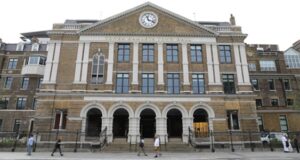Just as control of development in a large part of our borough was taken away by Margaret Thatcher in the 1980s, so too David Cameron has given huge chunks of planning powers to an unelected and unaccountable body. Even the initials are similar: where Thatcher handed power to the London Docklands Development Corporation (LDDC), Cameron’s given it to the LLDC – the London Legacy Development Corporation. Now the East End Waterway Group (EEWG) is raising serious concerns about whether the LLDC is set to destroy our waterway and industrial heritage.
The concerns are, for the moment, centred on Hackney Wick and Fish Island. The LLDC has agreed a Local Plan to govern development until 2031 – and it’s designated parts of these areas as “industrial conservation” areas. Other assets which fall just outside the actual conservation areas have been labelled “non-designated heritage assets”. According to the Local Plan, buildings in the area and with the designation are, basically, supposed to be restored and/or re-used so that the industrial heritage is preserved while the buildings continue or return to providing employment.
But what does this mean? EEWG has warned that the LLDC is interpreting the plan to mean that developers can keep a few original outer walls standing, but then erect an enormous new building behind them! There are also concerns that the LLDC will allow heritage buildings to be demolished completely.
For example, an application to develop the site of an Edwardian multi-storey stable block at Swan Wharf, Dace Road, London E3 – while simply retaining two outer walls of the original building – attracted over 70 individual objections, including representations from English Heritage, The Victorian Society, East End Waterway Group, Greater London Industrial Archaeology Society, The Hackney Wick and Fish Island Planning and Development Unit, The East End Preservation Society, Heritage of London Trust and SAVE Britain’s Heritage. There were also 1,041 signatures to an online petition. Objectors pointed out that the planning application was in breach of several local planning policies and documents.
In the face of these objections, the LLDC postponed its decision on the planning application, apparently so that it could discuss amendments with the applicant. The main amendment they came up with – which is now being consulted on – is that the new building they want to put up should only be five storeys high, rather than six. They have ignored the point that the objectors wanted to retain the original building and bring it back into use.
Objectors are not only concerned about the fate of this one site. If the LLDC goes allows this application, it is bound to set a precedent which would encourage developers to run riot in the Legacy area – just as they did on the Isle of Dogs. This would mean that all the LLDC’s planning documents (and those of several other bodies) would have been a complete waste of time, effort and money. And the people of London (Tower Hamlets and Hackney in particular) would not only lose the one really substantial remaining historic area of the Lower Lea Valley (which was London’s largest industrial area when London was the world’s largest industrial city and greatest port) but also the social and economic benefits of properly retaining and reusing its representative buildings.
 East London News A Force for the community…
East London News A Force for the community…




